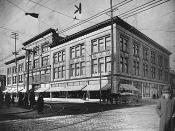Through Tom GoodwinÃÂs portrayal of the setting and atmosphere in ÃÂThe Cold Equations,ÃÂ the reader undoubtedly experiences the lonesome and cold feeling occurring in the story. The authorÃÂs brilliant use of figurative language and imagery illustrating BartonÃÂs occupation produces a character deficient of personality and feeling. This genius utilization of words forces the reader to experience a sense of urgency amidst the bitter conditions within the story. ÃÂThe Cold EquationsÃÂ is a fictional tale consumed with chilling imagery expertly depicted by the author, vividly generating a cold atmosphere lacking personality and emotion.
GoodwinÃÂs effective delineation of the ÃÂfrontier,ÃÂ the setting of which the story takes place, initiates the lonesome and cold aspect experienced in the tragic tale. ÃÂThe Cold EquationsÃÂ occurs in a futuristic time period, resulting in a scientific feel and a lack of understanding by the reader. ÃÂThe Stardust had gone through the usual procedure, dropping into normal space to launch the EDS with the fever serum, then vanishing again in hyperspace.ÃÂ
(Goodwin 3). The vast expanse of space cannot be comprehended by the human mind, resulting in the lonesome feeling previously stated. During the commencement of the story, much of the diction contains technical and scientific language. Science is free from emotion and personality, forming the cold mood felt by the reader. The authorÃÂs genius use of chilling and bitter imagery successfully portrays the cold, impersonal environment in the story.
Another aspect of the story that is used to enhance the ÃÂcoldÃÂ mood of story is the illustrations depicting the inside of the EDS space shuttle. Many characteristics of the EDS are especially futuristic and scientific. ÃÂThe communicator rapped brisk and metallic. ÃÂThis is ShipÃÂs Records. Give us all information on subjectÃÂs identification disk.ÃÂ (7) The quote suggests that the communicator is almost ÃÂrobot-like,ÃÂ a precise example of the detached imagery utilized by Goodwin. Inside the shuttle, we are also introduced to many futuristic items such as the identification disk. During the giving and receiving of the information on MarilynÃÂs identification disk, she is referred to as ÃÂNumber T8374ÃÂ (7). The suggestion that much of the world is computerized in that time period as well as the fact that each person is numbered, develops the impersonalism and coldness occurring in the story. Imagery in the story illustrates the EDS to be cold, metallic, and incredibly futuristic with dials, gauges, and numerous computers. As a result of this keen use of figurative language, the cold and impersonal atmosphere is developed thoroughly.
The description of BartonÃÂs profession reveals the lack of compassion and feelings of the beings inhabiting the year 2178. ÃÂHe was an EDS pilot, inured to the sight of death, long since accustomed to it and to viewing the dying of another man with an objective lack of emotionÃÂ ÃÂ (2) The possibility that humans in that time period can be accustomed to the sight of death is a detailed example of the impersonalism occurring. The law created that says ÃÂAny stowaways discovered in an EDS shall be jettisoned immediately following discoveryÃÂ (2) illustrates the fact that death in the ÃÂfrontierÃÂ is all too common. Death in itself creates a bitter, cold sense in the depths of the story, while loneliness, too is a key factor. Spending hours upon hours alone would be unbearable, along with that verity that if any ÃÂcompanionsÃÂ were to tag along, their fate would ultimately be death. The depictions of BartonÃÂs loneliness and the seriousness of his job enhance the cold and impersonal aspect to the story.
Tom GoodwinÃÂs successful illustrations of the ÃÂfrontier,ÃÂ as well as BartonÃÂs job, generate the detached and emotionless portion of the story. The cold mood the reader feels is a direct result of GoodwinÃÂs brilliant use of imagery and figurative language. The authorÃÂs imagery effectively enhances the story and atmosphere as well as creating a feeling of verisimilitude for the reader. This precisely vivid imagery invites the reader to experience the harsh conditions within the story. The cold, lonely, and impersonal characteristic of the setting is a key factor in developing the mood and overall atmosphere, successfully created by Goodwin in ÃÂThe Cold Equations.ÃÂ




